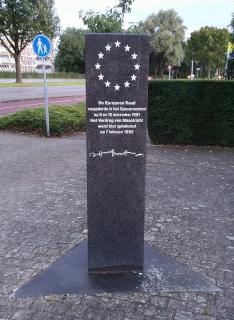
The Treaty on European Union, commonly known as the Maastricht Treaty, comes into effect on November 1, 1993, formally establishing the European Union (EU).
The international agreement is approved by the heads of government of the states of the European Community (EC) in Maastricht, Netherlands, in December 1991. Ratified by all EC member states (voters in Denmark reject the original treaty but later approve a slightly modified version), the treaty is signed on February 7, 1992. The treaty is signed on Ireland’s behalf by Minister for Foreign Affairs Gerry Collins and Minister for Finance Bertie Ahern.
Concluded in 1992 between the then-twelve member states of the European Communities, the treaty announces “a new stage in the process of European integration.” The treaty establishes a European Union (EU), with EU citizenship granted to every person who is a citizen of a member state. EU citizenship enables people to vote and run for office in local and European Parliament elections in the EU country in which they live, regardless of their nationality. The treaty also provides for the introduction of a central banking system and a common currency (the euro), commits members to implement common foreign and security policies, and calls for greater cooperation on various other issues, including the environment, policing, and social policy.
Although these provisions are widely seen to presage a “federal Europe,” the focus of constitutional debate shifts to the later 2007 Treaty of Lisbon. In the wake of the European debt crisis unfolding from 2009, the most enduring reference to the Maastricht Treaty has been to the rules of compliance – the “Maastricht criteria” – for the currency union.
Against the background of the end of the Cold War and the reunification of Germany, and in anticipation of accelerated globalisation, the treaty negotiates tensions between member states seeking deeper integration and those wishing to retain greater national control. The resulting compromise faces what is to be the first in a series of EU treaty ratification crises.
The twelve members of the European Communities signing the Treaty are represented by:
- Mark Eyskens and Philippe Maystadt (Belgium)
- Uffe Ellemann-Jensen and Anders Fogh Rasmussen (Denmark)
- Roland Dumas and Pierre Bérégovoy (France)
- Antonis Samaras and Efthymios Christodoulou (Greece)
- Gerry Collins and Bertie Ahern (Ireland)
- Gianni De Michelis and Guido Carli (Italy)
- Jacques Poos and Jean-Claude Juncker (Luxembourg)
- Hans van den Broek and Wim Kok (Netherlands)
- João de Deus Pinheiro and Jorge Braga de Macedo (Portugal)
- Francisco Fernández Ordóñez and Carlos Solchaga (Spain)
- Douglas Hurd and Francis Maude (United Kingdom)
- Hans-Dietrich Genscher and Theo Waigel (Germany)
(Pictured: Stone memorial in front of the entry to the Limburg Province government building in Maastricht, Netherlands, commemorating the signing of the Maastricht Treaty)
